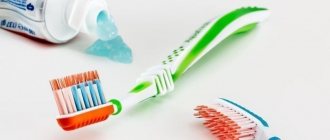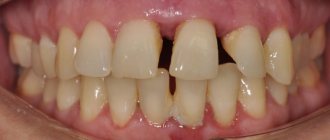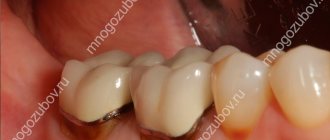Periodontitis begins with a slight inflammation of the gums, which is very easy to determine: soft mucous membranes bleed, especially when brushing teeth or when biting hard foods, and are not pinkish, but scarlet in color. In addition, plaque often forms on the teeth, which gradually turns into harder tartar. Inflammation from the gums gradually descends to deeper tissues and affects the ligaments that hold the tooth in the socket. In this case, we are talking about periodontitis.
Why is periodontitis dangerous?
Periodontitis leads to many problems, including:
- formation of massive dental deposits on the teeth and under the gums,
- bad breath as deposits rot,
- constant bleeding gums,
- general weakening of the immune system, disruption of the digestive system due to the inability to chew food thoroughly,
- mobility and complete loss of teeth.
Periodontitis, unfortunately, does not affect only one tooth. This is a disease that gradually spreads throughout the jaw, so if you do not seek help from a doctor in time, you can lose all the teeth in your mouth.
How to treat periodontitis if teeth are loose and falling out?
It is strictly not recommended to reach this stage, since it is rarely possible to save your own teeth. The only possible option is to extend their “life” by 2-3 years. This requires very long-term complex therapy:
- cleaning gum pockets : at the stage of periodontitis with tooth mobility, this is a surgical operation that is performed under local anesthesia. Duration - no more than an hour, during which the gum peels off the surface of the tooth, all deposits are removed, scraped out, the gum is returned to its place and sutured,
- splinting of teeth : in order to fix teeth in a stable position, mobile teeth are combined into one group along with healthy ones (if any in the oral cavity) using thin threads or splints. To do this, a small groove is created in the teeth on the side of the tongue, where the splint is placed, the cavity is closed from above with filling materials,
- installation of clasp dentures : if several teeth are already missing in the oral cavity, dentures can play the role of a splint, but only clasp dentures. They have a metal base, due to which the structure is given strength and hardness, the teeth can be fixed in a stationary state,
- therapeutic treatment : it is necessary to take medications that will help strengthen the ligaments around the tooth and normalize metabolic processes in the tissues. Medicines are often given as injections into the gums,
- thorough oral hygiene : the patient needs to maximize hygiene procedures, do gum massages and baths with herbal infusions.
All of the above remedies are mandatory in the treatment of periodontitis, especially in the presence of tooth mobility.
However, every patient should remember: if teeth become loose and even fall out, all methods will only prolong their life for a while - it is no longer possible to return the teeth to an ideally healthy state. Therefore, in case of serious stages of periodontitis, it is recommended not to waste money, time and nerves, but to immediately begin alternative treatment – dental implantation.
Why are teeth loose?
In childhood, loosening of teeth is physiological and does not require doctor’s intervention if it does not cause a lot of inconvenience to the child and does not interfere with the eruption of permanent teeth.
Why do teeth become loose?
- Physiological reasons
- Pathological causes
Physiological loosening is observed in preschool children when they change their baby teeth to permanent ones. In this case, their loosening is absolutely normal, since baby teeth do not have roots and do not sit tightly in the surrounding tissues. They are replaced by permanent teeth, which have a root connected to the bone tissue of the skull.
Treatment methods for periodontal disease
What to do if the doctor diagnoses periodontal disease, how to save teeth?
There are proven medications and folk remedies that help in the treatment of this insidious disease. Drug therapy usually produces good results. The dentist prescribes certain medications , based on how severely the teeth are affected. Before this, the patient undergoes a special test to determine the sensitivity of bacteria to the antibiotic that will be used for treatment.
Drug therapy includes the use of antibiotics and special anti-periodontal agents , the therapeutic effect of which is achieved thanks to the propolis included in their composition.
Medicines based on propolis relieve pain and inflammation, strengthen gums, and have a powerful antiseptic effect. But unfortunately, they help only at the early stage of the disease, and in more severe cases, antibiotic therapy is carried out.
An adult's teeth are loose: reasons
In adulthood, teeth also have a certain amount of looseness. Many people think that they are absolutely motionless, but this is not so. Minor vibrations of the teeth in the gums are allowed; this is literally a fraction of a millimeter, allowing you to chew food. If there were not these small gaps and movement of the teeth, then, most likely, they would crumble with the destruction of the jaw and skull bones.
However, significant loosening of the teeth, over a distance of approximately 1 mm in both directions, is considered pathological and can cause tooth loss. Such problems most often require a doctor’s examination and consultation. There are several reasons why teeth become loose in adults.
An adult's teeth are loose, reasons:
- Gingivitis
- Periodontitis
- Periodontitis
- Periodontal disease
All these diseases require treatment, which can be carried out both surgically, with the assistance of orthodontists, and at home. It all depends on the specific ailment.
Repairing a chip using composite material restoration
A chipped tooth is a common problem that our patients come to us with. Specialists at the Moscow Region clinic eliminate this defect in several ways, one of which is using a composite material.
The procedure has the following positive aspects:
- The use of modern composite materials that imitate dentin and enamel in the desired color range and transparency.
- The procedure lasts no more than 1.5 hours and takes only one visit to the dentist.
- Affordable price.
- No dental laboratory services required.
- The tooth is processed minimally; only carious tissues and old fillings are removed; healthy tissues are not trimmed.
- If minor defects arise after restoration, they can be easily and quickly eliminated.
However, the method has several disadvantages. Firstly, composite restoration requires systematic monitoring by the dentist. Over time, the shape and color of the corrected surface changes and needs to be adjusted. Composite materials quickly wear out and lose their original shine and color; roughness appears on the surface, which is filled with plaque. Secondly, the composite has low strength; five years after use, cracks appear, which disrupts the adhesion of the material to the tooth. As a result, chips are formed and the risk of re-development of caries. And thirdly, the restored area may differ from the rest of the teeth due to the difficulty of choosing a composite that is visually similar to dental tissue.
My front teeth are loose, what should I do?
Risk category:
- The disease most often occurs in children between 3 and 6 years of age.
- Diabetes
- Women taking hormones and oral contraceptives
- Complications after ARVI and sore throat, as well as influenza
My front teeth are loose, what to do:
- With gingivitis, the gums become inflamed and an infection penetrates into the gum pocket, which destroys the tissue and contributes to the loosening of the tooth. To cope with this problem, you need to thoroughly clean your teeth, use dental floss, irrigators, and special medications.
- Dentists often prescribe antiseptics to disinfect the cavity and prevent bacteria from growing in the pockets that form between the tooth and gum. Next, strengthening agents are prescribed that help make the gums denser and more elastic.
- The prognosis for the treatment of gingivitis is positive, since the connection between the gum and tooth is not disturbed, and only inflammation of the gums is observed. With proper treatment, it is possible to completely get rid of loose teeth and heal all kinds of wounds.
Expert opinion
Lyubov Ivanovna Kopylova
dentist-therapist
Experience: more than 10 years
The etiology of periodontal diseases is not fully understood. In addition to local factors, such as poor hygiene or smoking, decreased immunity, hereditary predisposition, etc. can contribute to the development of the disease. If an x-ray or orthopantomogram shows that the periodontal tissues are “sagging”, or if gum pockets and exposed necks are obvious on examination, it is necessary to address the problem as soon as possible, since the teeth may lose stability and must be removed.
Treatment of loose teeth due to gingivitis
Pathology occurs in case of complications of nasal breathing, chronic rhinitis or sinusitis, as well as a deviated nasal septum.
Treatment of loose teeth with gingivitis:
- Most often, gingivitis is treated on an outpatient basis, and if all the doctor’s recommendations are followed, it can be cured. For treatment, antibacterial agents are often used, which are used not only topically, but also internally. However, this method of treatment is used only in advanced cases when gingivitis progresses to periodontitis.
- To treat gingivitis, cephalosporin antibiotics, Penicillin, and Doxycycline are used. Hepilor, Givalex, and astringent liquids are used as rinses, which help disinfect the oral cavity and prevent the growth of bacteria.
- You can also use a solution of Miramistin, Chlorhexidine. Sometimes Decasan applications are used. These are all antiseptics that help eliminate pathogenic microorganisms. This applies not only to bacteria, but also to viruses and fungi that cause gingivitis.
Dial-Dent specialists who took part in this treatment
- Orthopedic dentist S.V. Zukor – diagnostics, treatment planning, preparation of treatment estimates.
- Surgeon T.R. Zhazykoev – tooth extraction under sedation.
- Anesthesiologist V.S. Kulakov – conducting sedation, monitoring the patient’s condition.
- Dentist-endodontist Yu.A. Borisova – treatment of dental canals under a microscope.
- Dental hygienist E. Smirnova – professional oral hygiene, preparation for dental treatment, selection of hygiene products, training in brushing teeth.
- Dental technician D.V. Wolf – making a temporary denture.
- Dental assistants L. Kharlamova, S. Mirvelova, A. Antoshkina.
See other examples of dental treatment and prosthetics here.
Make an appointment for a consultation by phone +7-499-110-18-04 or through the form on the website. You can ask questions about dental treatment and prosthetics to the chief doctor of the clinic, Sergei Vladimirovich Tsukor, at
How to strengthen your gums if your teeth are loose?
A fairly common cause of loose teeth is periodontal disease. This is the destruction of the tissues that surround the teeth, with the transition to the bone. As a result, the tooth initially becomes loose and then falls out.
How to strengthen your gums if your teeth are loose:
- There are several methods of treating this disease, the most popular are dental ones, which are carried out in the doctor’s office. A modern dentist has a huge number of instruments and devices that help cope with periodontal disease.
- At the initial stage, a treatment is carried out during which all plaque and tartar are removed, where bacteria and microorganisms that destroy the gums accumulate. Next, after cleaning, laser treatment can be carried out, during which the inflamed tissue drains and the areas surrounding the tooth are restored. After healing, the teeth are restored and no longer become loose.
- Also in dentistry, the help of an orthodontist is often used. If one specific tooth is loose, it has been treated, and there is no inflammation, then a kind of splint is often used. These are plastic or metal overlays that are fixed to the teeth using a special compound.
- Don’t worry, these products are attached on the side of the tongue, so they are not visible at all during a conversation, as well as a smile. Thanks to such splints, a loose tooth is fixed to two nearby ones, thereby stopping its destruction and loss.
Periodontist consultation
During the consultation, the doctor assesses the condition of the gums, teeth and surrounding bone.
Gum examination
The doctor examines the gums using a probe.
Examining your gums with a probe can be painful, but is necessary to determine the depth of the gum pockets. Normally, the probe can go under the gum no more than 3 mm. With a mild degree of periodontitis, the depth of the gum pockets is no more than 4-5 mm, with moderate severity of the disease - 5-6 mm, and with a severe degree, the depth of the pockets exceeds 6 mm and the teeth become very mobile. The doctor also pays attention to bleeding gums during the examination.
Bone condition examination
To assess the condition of the bone, a panoramic photograph of the teeth is taken (panoramic reconstruction using a CT scan of the teeth is possible). For a more accurate diagnosis, targeted photographs of the teeth may be needed. Dial-Dent has the necessary modern digital equipment for dental x-rays, including an orthopantomograph and a computed tomograph.
With a mild stage of periodontitis, an initial degree of resorption of the bone tissue around the tooth is noted, that is, the bone level deviates slightly from the norm; with moderate and severe stages, the bone level decreases significantly. With severe periodontitis, the bone level decreases so much that the roots of the teeth are exposed and this can be seen without x-rays.
A dental CT scan (panoramic reconstruction) shows a decrease in bone level - the red line shows the normal level (the patient has chronic generalized severe periodontitis):
Tooth mobility examination
In the moderate and severe stages of periodontitis, teeth become mobile. With severe periodontitis, there is a high risk of tooth loss.
How to strengthen loose teeth at home?
Nowadays, many people do not have much time to visit the dentist, so they strive to cure most diseases on their own. This can be done with simple manipulations. Below we present several remedies that perfectly help cope with loose teeth.
How to strengthen loose teeth at home:
- Salt is an excellent antiseptic and promotes tissue healing. To prepare the solution, use two teaspoons, which are diluted with 200 ml of water. The result is a fairly strong solution. A sip of this solution is taken into the mouth and held in it for one and a half minutes. It is necessary to roll the water from side to side to rinse out all the plaque from the teeth.
- Mustard can also be used along with salt. It helps to cope with gum inflammation and prevent tooth loosening. You need to mix a teaspoon of powder with a teaspoon of salt and add a little vegetable oil until you get fasting. This paste is applied to the teeth and left for 5 minutes. You can brush your teeth using a soft brush.
- Basil is great for relieving inflammation. To do this, you need to pour 1.5 teaspoons of dry and fresh leaves into 200 ml of boiling water and leave for 20 minutes. Next, you need to rinse your mouth with the mixture. Rinse should be done early in the morning and in the evening, before going to bed.
- In 2014, in one place of dental universities in the United States, they conducted a study, during which they found that coconut or sesame oil will help to cope with loose teeth due to periodontal disease. For treatment, you need to take a tablespoon of oil into your mouth and roll it from side to side for 20 minutes. Remember, this remedy should never be swallowed, but should be spat out. The product helps get rid of gingivitis and periodontal disease. It has a great effect on the condition of teeth and the tissues that surround them.
- Turmeric will help cope with periodontal disease and loose teeth. In order to cure the disease, it is necessary to dilute the spice with water until a paste is obtained. Next, the product is applied to a cotton swab and smeared on each tooth. The product is kept for 10 minutes. You can perform the procedure at night, after brushing your teeth. In the morning, clean with a soft toothbrush and rinse thoroughly. Remember, if you periodically experience periodontal disease, or peritonitis, you need to visit the dentist frequently.
Prevention of periodontitis
To prevent periodontitis, the patient is recommended to undergo professional teeth cleaning twice a year. If plaque forms on your teeth quickly, or you have problems with self-hygiene, then it is better to visit a hygienist more often, this will preserve the health of both your teeth and gums. Read more about prevention and hygiene measures here.
The patient took a break for some time to prepare financially for further treatment. Doctors did everything to maintain the health of the dental system while waiting.
A tooth becomes loose after an impact, how to strengthen it?
Many men have encountered a situation where, during a fight and a blow to the jaw area, their front teeth begin to loosen. There is no need to be upset; you need to see a doctor. There are several reasons why teeth become loose and hurt after an impact.
Causes:
- The first is a tooth root fracture. In this case, with almost one hundred percent probability it will have to be removed, since there is a fracture
- Tooth dislocation. The main symptom is loosening and change in position relative to the dentition
- Minor offset
A tooth becomes loose after an impact, how to strengthen it:
- In all these cases, immediately after a fight, it is necessary to provide this tooth with rest, eat only liquid food, refuse apples, crackers, nuts, as well as foods that need to be bitten off with the front teeth.
- Next, cold water is applied to the gum and lip to relieve swelling. After this, rinse your teeth with any antiseptic; the ideal option would be a solution of Furacilin, Decasan or Miramistin. This will help reduce the chance of re-infection. After all, in the area of dislocation there are damaged tissues that can become infected.
- If there is no fracture, but only a slight dislocation, then prolonged rest, as well as oral care with rinsing, after a few months helps to tighten the tooth and strengthen it. In this case, the tissue is restored and the tooth no longer wobbles. But most often, the help of a dentist is needed.
Repairing a chip by installing a veneer
Among the advantages of this method, we note:
- The strength and aesthetics of ceramics helps to achieve a result that is completely similar to natural teeth.
- Veneers, especially those made of zirconium oxide, serve their owner for a long time - with proper care, up to 15 years.
- Veneers are not subject to discoloration from exposure to dyes and have a long service life.
- Dental plaque does not settle on ceramics, as a result of which stones do not form. Zirconium dioxide can withstand high temperatures and is characterized by high density and strength.
- Veneer materials do not shrink, so if installed correctly there will be no loss of fit.
Before installing veneers, the doctor warns the patient about the disadvantages of this method. Veneers are an expensive procedure that requires at least minimal grinding of the tooth and the work of a dental technician in the laboratory. Installation involves several visits to a specialist and fitting of the material. If even a minimal chip of the veneer occurs, a complete rework of the structure will be required.
Treatment of loose teeth
You can save a tooth that has fallen out. Please note that if this happens, the tooth should never be completely dried out. Because this way you will make him dead.
Treatment for loose teeth:
- The ideal option is to put it by the cheek and in this position come to the doctor. You can put it in regular saline solution, which is sold at the pharmacy and costs a penny. In a container with saline solution, you need to bring the tooth to the dentist.
- The dentist places the tooth in place and splints it. That is, they apply a splint, fastening it to adjacent teeth. Special medications are prescribed that will prevent the development of infection and the attachment of bacteria to the affected area.
- Further, strengthening drugs may be prescribed that accelerate tissue healing. After 3-12 months, the splint is removed and the tooth is no longer loose. During this time, the bone tissue is restored, as well as the gums that are located around the tooth.
Advantages of treatment at Dial-Dent
There is a great advantage in clear treatment planning and budgeting. The patient knows the cost of treatment in advance (and does not find out about the upcoming expenses in the middle of the journey, when it is no longer possible to suspend treatment), plans his time and finances. With clear planning, costs are reduced (for example, when installing an implant, bone or soft tissue plastic surgery can be performed immediately, rather than breaking this process into two operations, using sedation twice), time is saved (several specialists can be visited in one visit to the clinic).
Proper treatment planning is helped by the fact that the clinic is equipped with modern diagnostic equipment (including a computed tomograph) and employs all the necessary specialists.
My front tooth is loose, how can I strengthen it?
The tooth is splinted. This is a common procedure performed for periodontal disease. The fact is that most often periodontal disease does not damage the entire dentition, but only a few teeth.
The front tooth is loose, how to strengthen it:
- To reduce the load, it is redistributed between other teeth. The manipulation is done during the period of remission of periodontal disease, under local anesthetic.
- The patient is injected with an anesthetic and a special device is used to cut out a furrow into which a fiberglass tape is inserted.
- Next, the “trench” is laid using special photopolymers, which harden under the influence of ultraviolet radiation.
- After curing, a kind of bridge is obtained that holds the dentition in a stationary state. This helps to redistribute pressure from one tooth to the entire dentition.
Home remedies are good, but you can still achieve excellent results and completely overcome the disease with the help of a dentist. The fact is that some gum diseases may have similar symptoms, but the causes may differ. The dentist will help you understand the cause that caused the disease and eliminate it.
Category Miscellaneous Published by Mister dentist
What problems does dental restoration solve?
By contacting a specialist, you can eliminate the following shortcomings:
- remove microcracks and chips on tooth enamel;
- restore the lost crown part of the tooth or change its color;
- correct large gaps between teeth;
- change the abnormal shape of a tooth;
- remove spots (enamel hypoplasia, fluorosis);
- build up dental tissue if teeth are susceptible to wear.
Dental restoration is carried out in two ways: direct and indirect. The choice of method depends on the degree of damage.
The direct method allows layer-by-layer application of special composite materials onto the damaged tooth, which, after grinding and polishing, completely restore the tooth surface. The indirect method is classified as an orthopedic dentistry service and is carried out in several steps.
Teeth restoration is carried out using artificial crowns, veneers or special inlays.











